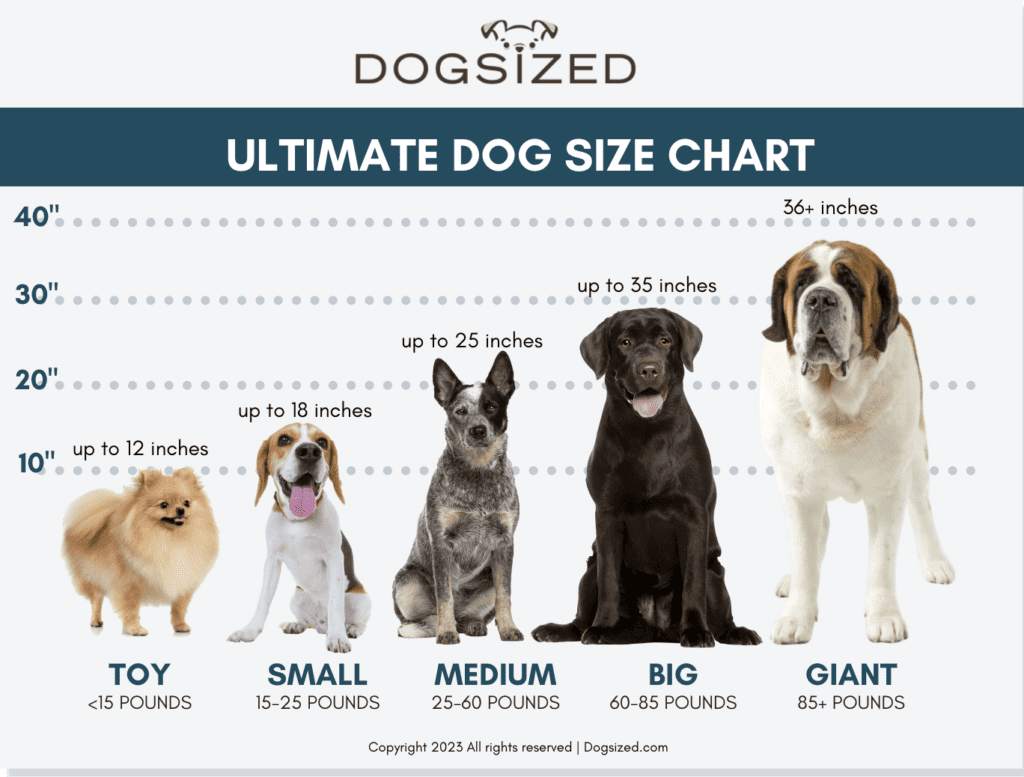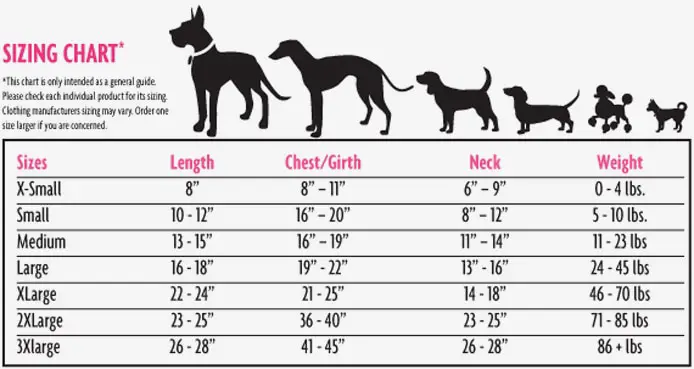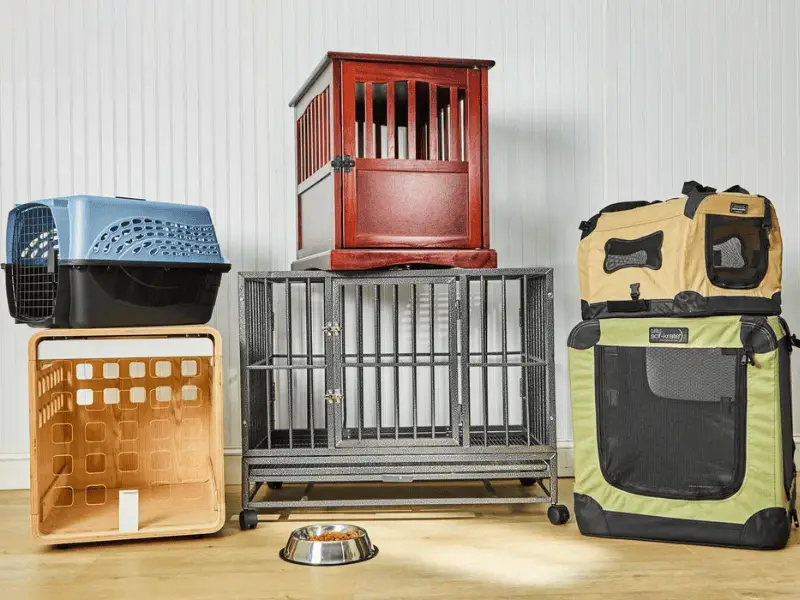When it comes to our beloved canine companions, size matters. From their health needs and exercise requirements to their temperaments and life spans, understanding your dog’s size is crucial to providing them with the best care possible. But with so many breeds and variations, how do we determine the right size category for our furry friends?

Fear not, fellow dog lovers! In this comprehensive guide, we will delve deep into the world of dog sizes, exploring the characteristics of small, medium, and large dogs and the methods to determine their size category.
We will highlight popular breeds in each category and provide essential measuring tips for clothing, collars, harnesses, and beds. So, whether you’re a proud pet parent or looking to welcome a new pup into your home, this ultimate size chart for dogs is just what you need!
Short Summary
- Understanding the importance of dog size and its connection to health, temperament, and life span.
- Either weight or breed classification determines size categories for dogs. Popular breeds include Chihuahuas, Pomeranians, German Shepherds & Golden Retrievers.
- Proper sizing is essential when selecting products such as clothing collars/harnesses & beds. Special considerations may be needed for giant breeds.
Understanding the Importance of Dog Size

Dog size isn’t just about aesthetics; it plays a significant role in their overall health, temperament, and life span. While their size may be the first thing we notice, it’s essential to understand that different size categories come with their unique needs and potential health issues.
Small Dog Characteristics
Small dogs, such as Chihuahuas, Yorkshire Terriers, and Toy Poodles, typically weigh less than 24 pounds and are known for their lively and loyal personalities.
These tiny companions often pack a big punch regarding energy, requiring regular exercise to keep them happy and healthy.
However, their diminutive size also means they may be prone to certain health issues, particularly dental problems, which can arise from overbreeding or unethical breeding practices.
Teacup dogs, an even smaller subset of small breeds, have recently gained popularity. While they may be irresistibly cute, it’s important to note that the American Kennel Club does not support teacup breeders or recognize teacups as an officially recognized breed.
Moreover, regardless of size, small dogs still require proper training to prevent them from becoming overly assertive and taking control of your daily life.
The health concerns surrounding brachycephalic (flat-faced) small breeds such as Pugs and French Bulldogs are also worth mentioning.
These breeds are prone to respiratory and eye issues due to their facial structure, leading veterinarians to advise against purchasing flat-faced breeds.
Medium Dog Characteristics
Medium-sized dogs, such as Labrador Retrievers, Australian Shepherds, and Border Collies, typically weigh between 24 and 59 pounds and are known for their active and energetic nature.
These dogs often require regular exercise and mental stimulation to keep them happy and healthy.
Some of the most popular medium-sized breeds include Beagles, Boston Terriers, and Jack Russell Terriers.
While medium-sized dogs don’t face the same dental issues as small breeds, they can still be susceptible to other health problems, such as hip dysplasia, elbow dysplasia, von Willebrand’s disease, and epilepsy. These potential health issues can be managed or even prevented by providing proper care and routine veterinary visits.
When it comes to training and socialization, medium-sized dogs are often seen as the “Goldilocks” of the canine world – not too small and not too large, but just right.
Their size makes them more manageable for many pet parents, and their intelligence and adaptability often make them excellent companions for various activities and lifestyles.
Large Dog Characteristics
Large dogs, such as German Shepherds, Golden Retrievers, and Rottweilers, typically weigh over 60 pounds and are known for their strength, loyalty, and protective instincts. Due to their size and energy, these gentle giants require more exercise than their smaller counterparts and a larger living space to accommodate their size.
However, their large size also comes with potential health issues. Large dog breeds are more prone to joint diseases like hip or elbow dysplasia and arthritis, as well as other health problems like weight gain, bloat, cancer, and cardiac diseases. Regular veterinary checkups and a balanced diet are essential for maintaining their overall health and well-being.
Giant breeds, such as Great Danes and Mastiffs, are a special category of large dogs that require additional consideration when it comes to their care. These gentle giants have a shorter life span, typically ranging from six to eight years, and face more severe health issues than their smaller counterparts.
They also have different nutritional needs, often requiring supplements to support their joints and bones. Consulting a veterinarian regarding breed-specific nutrition is highly recommended if you decide to bring a giant breed into your home.
Determining Your Dog’s Size Category

Now that we’ve explored the characteristics and health concerns associated with different dog sizes let’s delve into how to determine your dog’s size category.
There are two main methods for classifying dogs by size: weight-based classification and breed-based classification. Both methods divide dogs into three categories: small, medium, and large, with some classifications including an additional “giant” category for exceptionally large breeds.
Understanding your dog’s size category is crucial for making informed decisions about their care, such as the amount of exercise they require, the size of their dog house, or even the type of products you purchase for them. Read on to learn how to determine your dog’s size category using weight-based and breed-based classifications.
Weight-Based Classification
Weight-based classification is the simplest method for determining your dog’s size category. Small breed dogs typically weigh less than 22 pounds, medium breed dogs weigh between 22 and 55 pounds, and large breed dogs weigh over 55 pounds.
Some examples of popular breeds in each category include Chihuahuas, Pomeranians, and Toy Poodles for small breeds; Beagles, Cocker Spaniels, and Bulldogs for medium breeds; and German Shepherds, Labrador Retrievers, and Golden Retrievers for large breeds.
As mentioned previously, giant breeds are a special category of large dogs that require additional considerations when it comes to their care.
These massive pups typically weigh over 100 pounds and face unique health challenges, such as a higher risk of joint issues and a shorter life span. If you’re considering bringing a giant breed into your home, you must be aware of these special considerations to ensure their health and well-being.
Breed-Based Classification
Breed-based classification involves estimating your dog’s adult size based on their breed. This method considers the breed averages specific to your dog, which can offer a more accurate estimate of their adult size.
To gauge your dog’s size category based on breed, you can use a puppy weight calculator or assess their bone structure and paw size to understand their adult size.
While both weight-based and breed-based classifications have their merits, it’s important to remember that individual dogs may vary in size, even within the same breed. Ultimately, understanding your dog’s size category can help you make informed decisions about their care and ensure their health and happiness throughout their life.
Popular Breeds for Each Size Category

Now that we’ve covered the methods for determining your dog’s size category let’s explore some popular breeds in each category. This will not only give you a better idea of the various breeds available, but also help you find the perfect fit for your family and lifestyle.
The Chihuahua, the Pomeranian, and the Toy Poodle are popular choices for small dogs. These breeds are known for their intelligence, loyalty, and affectionate nature. They are.
Favorite Small Breeds
Small dog breeds have captured the hearts of pet parents worldwide thanks to their adorable appearance and endearing personalities. Some popular small breeds include Chihuahuas, Yorkshire Terriers, Pomeranians, Toy Poodles, and Maltese.
These pint-sized pups often make excellent companions for those living in apartments, as their small stature and lower exercise requirements make them well-suited for smaller living spaces.
While their size may make them seem easy to manage, it’s crucial not to underestimate the importance of training and socialization for small breeds.
Without proper guidance, these tiny dogs can develop assertive and controlling behaviors that can disrupt your daily life.
Additionally, small dogs can be prone to dental issues and other health problems, so it’s essential to provide regular veterinary care and a balanced diet to ensure their long-term health and happiness.
Lastly, it’s important to remember that not all small breeds are created equal. Teacup dogs, for example, have become increasingly popular but face a host of health issues and ethical concerns surrounding their breeding practices.
When considering a small breed, it’s essential to research their specific needs and potential health concerns to ensure you’re prepared to provide the best care possible.
Top Medium Breeds
Medium-sized dog breeds offer a perfect balance between the tiny stature of small breeds and the impressive size of large breeds. The Beagle, Boston Terrier, Jack Russell Terrier, and Cavalier King Charles Spaniel are some of the most popular medium breeds.
These breeds are known for their energy, intelligence and affectionate nature. These dogs are often highly adaptable and can fit into a variety of living situations, making them an excellent choice for many families.
Medium-sized dogs are generally quite active and require regular exercise to keep them happy and healthy. As with any dog, it’s essential to provide proper training and socialization from an early age to ensure they grow up to be well-mannered and obedient companions.
While medium-sized dogs may not face the same dental issues as small breeds, they can still be susceptible to other health problems, such as hip dysplasia, elbow dysplasia, von Willebrand’s disease, and epilepsy. Regular veterinary visits and a balanced diet can help manage or even prevent these potential health issues.
When considering a medium-sized breed, it’s important to research the specific needs and potential health concerns associated with the breed. This will ensure you’re well-equipped to provide the best care possible and enjoy a long, happy life together.
Leading Large Breeds
Large dog breeds have long been admired for their strength, loyalty, and protective instincts.
The German Shepherd, Golden Retriever, Rottweiler, and Newfoundland are some of the most popular large breeds. These breeds have become increasingly popular due to their size. These gentle giants often form strong bonds with their families and make excellent companions for those looking for a protective and loving pet.
Due to their size and energy, large dogs require more exercise than their smaller counterparts and ample living space to accommodate their larger frames. Regular walks and playtime are essential to keep these dogs happy and healthy.
However, their large size also means they may be more prone to joint diseases like hip or elbow dysplasia and arthritis, as well as other health problems like weight gain, bloat, cancer, and cardiac diseases. Regular veterinary checkups and a balanced diet are essential for maintaining their overall health and well-being.
Giant dog breeds, such as Great Danes and Mastiffs, require special consideration when it comes to their care. These massive pups have a shorter life span, typically ranging from six to eight years, and face unique health challenges, such as a higher risk of joint issues and different nutritional needs. If you’re considering bringing a giant breed into your home, it’s essential to be aware of these special considerations to ensure their health and well-being.
Measuring Your Dog for Proper Sizing
Now that you better understand the various dog sizes and popular breeds, it’s time to learn how to measure your dog for proper sizing. Accurate measurements are crucial when it comes to purchasing clothing, collars, harnesses, and beds for your furry friend.
The following sections will provide essential measuring tips and size charts to help you find the perfect fit for your canine companion.
Clothing Measurements
Measuring your dog for clothing may seem like a daunting task, but with a few simple tips, you can ensure a comfortable and stylish fit. To accurately measure your dog for clothing, wrap a soft tape measure behind your dog’s armpits, around their rib cage, and over their shoulder blades for the chest girth measurement. Then measure the length from the base of their collar to the base of their tail. If your dog falls between sizes, it’s best to select the larger size to ensure a comfortable fit.
When it comes to selecting the right size clothing for your dog, it’s important to consider their breed as well. Some breeds, such as Golden Retrievers, Cocker Spaniels, and French Bulldogs, may require different sizes due to their unique body shapes. Always refer to the size chart provided by the brand you are purchasing from to ensure the best fit for your furry friend.
Collar and Harness Measurements
Measuring your dog for a collar and harness is equally important to ensure their safety and comfort. To accurately measure your pup for a harness, use a soft tape measure and pull the tape snug but not tight around the widest part of your dog’s chest, behind their front legs. For the neck measurement, please measure the widest part of their neck, making sure to leave enough room to slip two fingers between the harness and your pup’s body.
When selecting a collar or harness for your dog, it’s also essential to consider their breed. Breeds such as Chihuahuas, Pugs, and Maltese may require different sizes due to their unique body shapes. Always refer to the size chart provided by the brand you are purchasing from to ensure the perfect fit for your canine companion.
Bed Measurements
A comfortable and supportive bed is essential for your dog‘s overall health and well-being. To determine the ideal size for a pet bed, measure your dog while they are in their typical sleeping position and add 4-6″ for cats and small dogs or 8-12″ for medium to large dogs. This will ensure they have enough space to stretch out comfortably and get a good night’s sleep.
As with clothing and collars, it’s important to consider your dog’s breed when selecting a bed size. Some breeds, such as Dachshunds, Corgis, and Beagles, may require different sizes due to their unique body shapes. Always refer to the size chart provided by the brand of the product being purchased to find the perfect fit for your furry friend.
Size Charts for Various Dog Products
Now that you’re equipped with the knowledge and measuring tips to ensure the perfect fit for your dog, let’s explore the size charts for various dog products. These charts will provide you with the necessary measurements and sizing details for a range of items, including clothing, collars, harnesses, and beds.
Remember, always refer to the specific size chart provided by the brand you are purchasing from for the most accurate sizing information.
Clothing Size Chart
The size charts for dog clothing vary depending on the brand and type of clothing. Generally, the most important measurement is the dog’s chest, length, and neck measurements.
It is essential to measure your dog and refer to the specific size chart provided by the brand you are purchasing from for the best fit.
Collar and Harness Size Chart
The size charts for collars and harnesses can vary depending on the brand and type of product. It is essential to measure your dog’s neck size and chest size and then refer to the size chart provided by the brand you are purchasing from. This will ensure the perfect fit and avoid any discomfort for your canine companion.
Bed Size Chart
The size charts for beds vary depending on the brand and type of product. It is essential to measure the dog’s length and width and refer to the specific size chart provided by the brand of the product being purchased.
You can provide your furry friend with a comfortable and supportive place to rest and recharge by selecting the right bed size.
Special Considerations for Giant Breeds
Caring for giant breeds, such as Great Danes and Mastiffs, requires special consideration due to their unique needs and challenges. These massive pups typically weigh over 100 pounds and have a shorter life span, often requiring supplements to support their joints and bones.
Additionally, because of their size, giant breeds need more space and exercise than smaller breeds and special clippers for their thicker nails.
If you’re considering bringing a giant breed into your home, it’s essential to be aware of these special considerations and consult with a veterinarian regarding breed-specific nutrition and care. By providing the proper care and attention, you can ensure the health and happiness of your gentle giant for years to come.
Summary
This comprehensive guide has explored the importance of understanding dog sizes and the characteristics, health concerns, and popular breeds associated with small, medium, and large dogs.
We have also provided essential measuring tips and size charts for various dog products, including clothing, collars, harnesses, and beds, to help you find the perfect fit for your furry friend.
By understanding your dog’s size and unique needs, you can make informed decisions about their care, ensuring their health, happiness, and well-being throughout their life. After all, our canine companions deserve the best we can offer, and with the right knowledge and tools, we can provide them with a lifetime of love and support.
Frequently Asked Questions
How do I know my dogs size?
You can estimate your dog’s size by calculating their weight at 20 weeks old and double it.
Additionally, you can measure their body length from the top of their shoulders to the base of their tail to better indicate their size.
What size clothes does my dog need?
Based on your dog’s size, it looks like they will need a size S shirt or tank. The shirts and tanks are designed to fit dogs measuring up to 10″ from collar to tail base.
What size is a medium dog?
Medium-sized dogs weigh between 20 and 60 pounds and generally stand between eight and 27 inches tall. These breeds of dogs come in a variety of coat types, activity levels and temperaments to suit any lifestyle.
No matter what kind of lifestyle you lead, there is sure to be a medium-sized dog that is perfect for you. They are loyal, loving companions that can provide years of joy.
How to measure a dog for clothes?
Measuring your dog for the correct size of clothing can be easily done at home. Start by taking their length measurement, running from the collar’s base to the tail’s base. Then measure the widest part of your pup’s chest around their ribcage.
Finally, take a neck measurement, running the measuring tape all the way around. With these three measurements, you’ll be able to find the best fitting clothes for your furry friend!
ALSO READ


